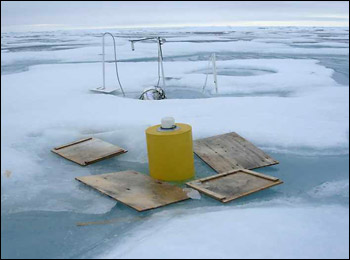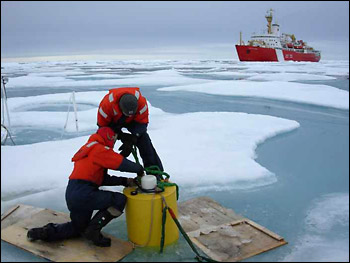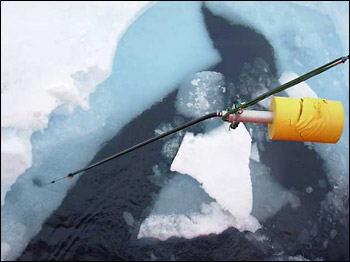Please note: You are viewing
the unstyled version of this website. Either your browser does not support CSS
(cascading style sheets) or it has been disabled. Skip
navigation.
Rick KrishfieldSeptember 10, 2006
With the cooperation of the seismic group (see Dispatches 6 and 24), the Louis was able to transect a course toward the buoy pair while the tow sled (now named NATASHA for Near Astern Triple Airgun Seismic Hydrophone Array) acquired data overnight. Sunday morning was too foggy to fly, but by afternoon the weather cleared. Yet no flight was necessary since the buoy appeared straight ahead based on the latest locations and some dead reckoning by the Captain. Flight operations did ensue to land the WHOI mooring team on the ice so that we could assess how to recover the ITP while not disturbing the IMB. We had brought with us a hot water melter apparatus which could cut circular cores through the ice up to 36" in diameter. The ice core is typically removed using a tripod and chainsaw to cut the ice core into manageable pieces that can be removed by hand. We also planned to use our tripod winch in reverse with a heavy duty electric drill to haul the mooring cable. Unfortunately, we did not plan on the ITP system being in a melt pond with uneven surfaces all around. We needed a level surface for the winch system that we brought along. Therefore, we moved on to Plan B. Plan B was our plan to have the icebreaker crack the icefloe to release the buoy into open water where we could pick it up using the foredeck A-frame. This plan assumed that the ice would be pliable enough that it could be broken up easily, but did not account for the tough old 2.5-3 m (8-10 ft) thick icefloe that still maintained the ITP/IMB system. What would also make this plan especially difficult was the desire to maintain the IMB. Well, to make a long story short, the recovery operation was unsuccessful despite the excellent ship handling by the Captain to crack the icefloe just by the ITP, but without fracturing the floe near the IMB. Unfortunately, the icefloe cracked about 1 ft away from the ITP buoy so that it was never released. The remaining icefloe was so thick that it could not be cracked further by the Louis, but only submerged by the weight of the ship. After it became apparent that the ITP could not be recovered by pursuing this course, we decided to halt the operation rather than jeopardize the integrity of the IMB. While everyone was disappointed that we did not recover the ITP after it looked like a sure thing, we recognized that a lot of experience was gained on how to recover these systems in the future. Considering that there are now four ITP systems in service in the Arctic, we hope that we will eventually get the opportunity to take advantage of this hard-earned knowledge. Last updated: October 7, 2019 | |||||||||||||||||||||
Copyright ©2007 Woods Hole Oceanographic Institution, All Rights Reserved, Privacy Policy. | |||||||||||||||||||||






